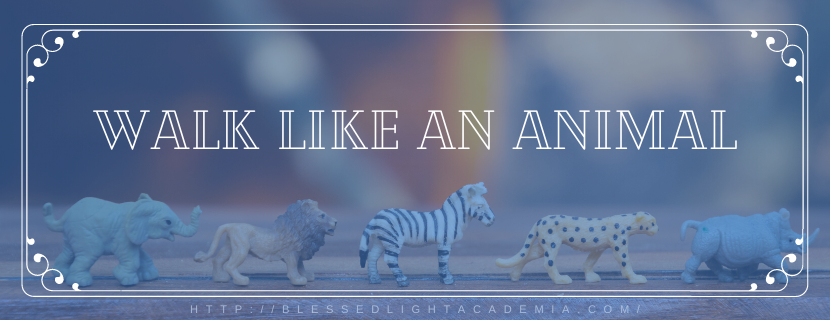It’s cold here, like really cold. We finally are warming up slightly, with 0° – 10° this week. It’s been -25° or so for the past month. Makes it hard to want to leave the house; which leads to cabin fever, which leads to crazy kids and stressed out mom.
An easy way to break out of the rut, and burn energy in the process is having the kids go through different modes of walking that exist in the animal kingdom. (this makes a great segue into the mechanics of the animals that cause them to move that way!)
Some of the basic walks you probably were conned into doing shown how to do at school. The crab walk, bear walk, elephant, etc. They are all really fun to do. PLUS, it is an opportunity to get the sillies out and get them up off their butts and moving. After you go through these, (or as you are) ask your kids if they can think of a walk that you haven’t done yet. Kid made walks are so much fun to see.
Many of these movements require core strength, balance, and agility, while developing the important gross motor skills. Animal walks are simple and fun exercises that connect us with the outside world and burn off that extra pent up energy.
Seal Slide
Lie on your stomach then push up on hands until the arms are straight. Then move across the room while dragging your legs.
Crouching Tiger
This is a very low crawl with maximal control in the extension of the elbows (controlling the range of motion with triceps). Get on all fours, and bend your elbows while keeping palms on the floor, your spine should be parallel to the floor, which means you won’t be crawling on your knees, but on your tippy toes.
Bear Walk
Start in the standing position. Bend over and put both hands on the ground. Now, walk forward with the same leg and arm. So, move your right arm and right leg forward, then the left leg and arm at the same time, then repeat. For additional challenge, try keeping your legs and arms straight.
Flamingo Hop
Stand on one foot and do a small jump. With each hop, switch off which leg is raised to practice balancing.
Turtle Crawl
Starting in the kneeling position, curl your back over and put your elbows on the ground. Keeping your bottom on your heels, and your elbows and hands on the ground, pull yourself forward in a slow motion.
Kangaroo Jumps
Starting in the standing position, put both feet together and squat down. Jump as high as you can using only your feet, and no hands.
Elephant Walk
Start in the standing position and bend over with your hands held together. Keeping your back straight and parallel with the floor, hang your hands under your shoulders and swing them back and forth as you walk with straight legs across the floor.
Frog Jumps
Start in the squatted position. Place your hands on the floor in between your knees. Using your feet, jump forward and land with your hands and feet on the ground.
Duck walk
This a moving squat position where you are trying to stay as low as possible the entire duration of the exercise. Keeping your hands on your rib cage, palm out; squat down on your feet, and without standing, walk forward. (not every kid is going to have the balance for this one!)
Crocodile Crawl
Laying on your belly, put your hands in front of your face, and your feet pointing out. Using your hands and toes, push your body across the floor; never letting your hands go behind your shoulders.
Deer Leaps
Keeping your arms close about your body, leap with one leg at a time, trying to stay up on your toes as much as possible.
Penguin Walk
Keeping arms straight by your side, heels together and take short, quick waddling steps.
Snake Slither
Lie on stomach, arms to your sides, and legs together; and move forward, only by wiggling and pushing with toes.
Horse Run
Galloping is great for gross motor skills. Skip as high as you can with one foot forward. Leg movements need to be coordinated and timed correctly, and acting like horse is a fun way to practice.
Bunny Hops
Remember, bunnies are quiet; so landing softly is important. Put hands together in front, feet together, and jump forward while keeping the spine erect.
Spider Creep
Start by squatting down close to the ground. Lean backwards and place your hands on the ground. You should look like a “table top” now. Now walk forward, while holding your bottom off the ground and your back straight.
Crab Walk
Put your hands out at shoulder level and ‘click’ your ‘claws’. While squatting, walk sides a few steps, then ‘click’ your ‘claws’ again. The spine should remain straight.
Ask about the sounds and calls of the animal during their movement; like snake slither, “What sound does a snake say?” Ask questions about the animal they are pretending to be: Do they like hot or cold weather? What other animals live there? What colors are they? Where do they live? Do they like the water? How long is their lifespan? Do they have special names for groups or babies?



What a fun way to get active during the day, especially when no one wants to leave the house.